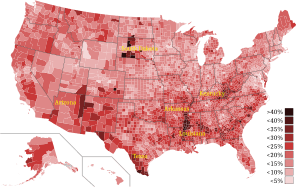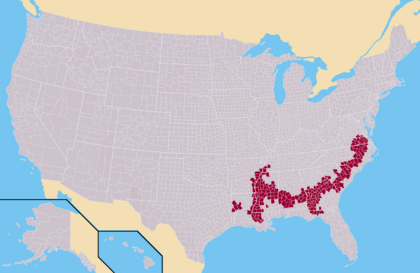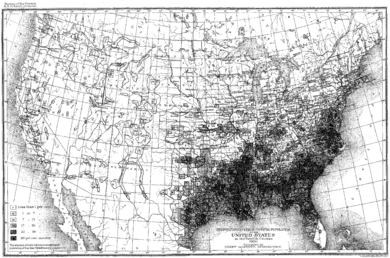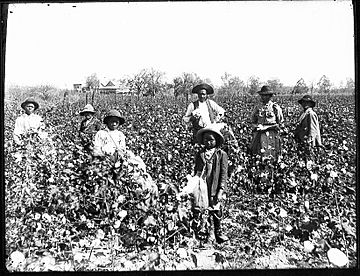Black Belt in the American South facts for kids
Quick facts for kids
Black Belt in the American South
|
|
|---|---|
|
Cultural region of the United States
|
|
| Country | |
| States | |
The Black Belt in the American South is a special region in the Southern United States. It gets its name from two things. First, it has very rich, dark soil that's great for farming. Second, it's a historical area where many African Americans lived, especially during and after slavery.
Long ago, this area was known for its big cotton farms. These farms were owned by wealthy white people. The work was done by many poor, mostly Black enslaved people. In some places, Black people made up most of the population. After 1945, machines started doing much of the farm work. This led many Black workers to move to cities in the Midwest and West. This big move was called the Great Migration. Today, the term "Black Belt" still describes about 200 counties from Virginia to Texas. These counties have a history of many African-American residents and cotton farming.
Contents
What is the Black Belt?
By the late 1800s, people often used the term "Black Belt." It was well-known across the United States. In 1894, a newspaper called The Nation wrote about it. They said 12 counties in Alabama had twice as many Black people as white people. These counties formed the main part of the famous Black Belt.
By 1900, "Black Belt" was used to describe a political region. It was like other terms such as the snow belt or sun belt. Booker T. Washington, a famous leader, explained the term in 1901. He said it first meant areas with thick, dark, rich soil. This soil was perfect for growing crops. So, many enslaved people were brought there to work. After the American Civil War, the term also meant counties where Black people outnumbered white people.
The exact borders of the Black Belt can change. It depends on how you define it. For example, you can look at census data. This data shows which rural Southern counties had a large Black population in a certain year. In 1980, Southern counties with at least 25% African-American people made up 29% of the South's population. By 2005, this dropped to 23%.
In 1936, a researcher named Arthur Raper described the Black Belt. He said it was about 200 farm counties. In these counties, more than half the people were Black. They stretched in a curve from Virginia to Texas. Even after many Black people moved away from 1940 to 1970, the University of Alabama still calls about 200 counties the Black Belt today. These areas still have many Black residents.
Leaders like Martin Luther King Jr. used the term "Black Belt" often. In 1962, he wrote about his tour through Virginia's Black Belt. He said that the idea of "massive resistance" against civil rights started there. In 1964, King chose Selma in the Black Belt for a major civil rights campaign. This was because it was a small, non-city area. It was the best place to focus on getting new voting rights laws passed.
Political Power in the Black Belt
After the Reconstruction era ended in 1877, a group called the "Redeemers" took power. They were Southern Democrats who wanted to bring back white supremacy. They removed Black and white Republicans from government jobs.
Voting Rights and Disenfranchisement
From about 1890 to 1907, white Democrats passed new laws. They also used local rules to stop African Americans from registering to vote and voting. This happened all over the South. States became controlled by only one party, the Democrats. The real elections happened within the Democratic Party. Black people were not allowed to take part in these. This went against the Fifteenth Amendment to the United States Constitution. This amendment was supposed to protect the right to vote for freedmen (formerly enslaved people). Congress did not stop these actions, and the Supreme Court mostly agreed with them.
After 1900, most African Americans in the Black Belt could not vote. Only a few ministers, business owners, and teachers could. White landowners, merchants, and bankers held almost all the political power. They controlled local governments. They also controlled state governments. They drew voting districts in a way that gave more power to rural areas. This meant cities had less say.
By the 1950s, many counties had "Citizens' Councils." These groups were part of a network of white supremacist organizations. They strongly opposed racial integration, especially in public schools.
Changes in the 1970s
The situation changed in the 1970s because of federal action. The Voting Rights Act of 1965 was strictly enforced. This law helped more people vote. Also, in the 1960s, the US Supreme Court made important rulings. They said that states had to redraw voting districts based on population. This was called "one man, one vote." This rule meant that everyone's vote should count equally. As a result, political power moved more towards cities and industrial areas.
Farming and Life in the Black Belt
Until the mid-1900s, farming in the Black Belt relied on white landowners and Black tenant farmers or sharecroppers. Tenant farmers usually owned their tools. Sharecroppers didn't own anything and paid the landowner with a part of their crop. Very little money was used.
Challenges for Farmers
The early 1920s were very hard for cotton farmers. The boll weevil, a small beetle, spread across the cotton-growing South. It destroyed crops. The price of cotton also dropped a lot. Land prices fell, and taxes went up. Many farms were lost before the Great Depression started in 1929. Banks in the Black Belt saw their money deposits drop by half or more. This made people afraid to use banks. Government programs during the New Deal helped landowners more than tenant farmers.
After the Civil War, large plantations were divided into smaller farms. These were given to tenant farmers. The tenant farmer and their family worked the land. They planted and harvested the crops. Throughout the year, they bought food and supplies on credit from local stores. At harvest time, they sold their cotton. Then they paid the store and the landowner. Often, not much money was left. Landowners also farmed some land directly, paying Black workers in cash. White landowners held all the political power. They did not want government welfare programs. These programs would have given cash to workers. This would have changed the cashless farming system.
The Great Migration
There were few other jobs in the Black Belt. During World War II, factories opened or changed to make war supplies. Many African-American farmers left to join the army or take cash-paying jobs. They moved to nearby or distant cities, especially on the West Coast. This was part of the Great Migration.
After the war, new machines like tractors and cotton harvesters became common. Farmers also started using chemical weed killers. Many landowners began farming their land themselves. They needed fewer farm workers. This forced many tenant farmers and sharecroppers to leave the land. This led to an even bigger move of Black people to the North and West. This was called the Second Great Migration. Different crops replaced cotton and tobacco. Large-scale industrial farming became common in many parts of the region.
Life in the Black Belt Today

The rural Black Belt, with its mostly African-American population, has often faced challenges. It has ranked low in areas like poverty rates, income, and education. For example, transportation routes have often been poor in this region. Even today, air travel options are limited.
Historically, the government focused on large farms. This made it harder for small farmers, especially in the Black Belt. In 1913, the USDA planned to give payments to farmers. But many small farmers felt ignored. They felt the government's efforts were not fair. The USDA mostly helped large, industrial farms. This pushed small farmers, many of whom were Black, off their land.
Industrialization also affected Black farmers. Chemical herbicides used to grow crops faster damaged the land. Farmers could no longer rely on crops like cotton to support their families. Even farmers with some savings struggled. Family farms were replaced by industrial methods. This made it very hard for these families and their farms to survive.
Alabama's Black Belt
Religion and Community
In the late 1800s, formerly enslaved African Americans in Alabama lived mostly in the Black Belt. This area ran across the middle of the state. They started their own churches, separate from white control. Baptist churches grew very fast among Black people. In 1890, there were 71,000 Baptist members in Alabama. 86% of them were African American. By 1916, this number grew to 215,000.
White Religion
Before the Civil War, wealthy landowners in the region belonged to churches like Presbyterian, Episcopal, or Methodist. After the war, many lost money and moved away. Membership in Presbyterian and Episcopal churches fell. Among white people, Methodist and Baptist churches grew. New groups like Holiness and Nazarene churches also started to appear.
White Baptist churches held services on Sundays. They also had Sunday school for children. During the week, there were prayer meetings. Pastors often talked about the need for religious revivals. They also spoke against things like card playing and dancing. By 1900, sermons started to cover new social topics. They talked about working with other Protestant churches. They also showed more interest in issues like underpaid workers. However, they did not talk about racial tensions or violence.
Black Religion
Many enslaved people became Christians before the Civil War. Their worship was lively, with strong participation from the church members. They were often led by a powerful minister who was also a community leader. By 1867, freedmen started their own all-Black churches. Northern Methodist missionaries helped organize some of these. The African Methodist Episcopal Church and African Methodist Episcopal Zion Church were very popular. These were the first independent Black church groups. Their missionaries started thousands of new churches.
Many Black people also started independent Baptist churches. They quickly formed congregations without white supervision. By 1881, there were 50 church groups, 600 churches, and about 90,000 members in Alabama. Most of their ministers were great speakers but had little formal education. Black Baptists were also active in Sunday schools and missionary groups.
During the Reconstruction era (1863–1877), there was often racial tension and violence. But in Alabama's Black Belt, a system called sharecropping helped create some peace. Black farmers worked under the protection of rich white landowners. Sharecropping allowed white landowners to make money. It also gave Black workers more freedom compared to slavery. Because of this, there was less white supremacist violence in the Black Belt than in northern Alabama. Black tenant farmers had some power. White landowners were at the top, but Black farmers were important in the economy.
Georgia's Black Belt
Women in the Black Belt
Recently, historians have studied the lives of women in the Black Belt. Chrissy Lutz and Dawn Herd-Clark looked at Black housewives in Georgia's Black Belt in the 1920s and 1930s. These women worked with outside groups to improve their homes and finances. Fort Valley State College, a college for Black students, worked with the Cooperative Extension Service. This service trained Black organizers. They set up local clubs and gave demonstrations on farming and home skills. They taught cooking, hygiene, sewing, gardening, and raising chickens. These programs not only taught new skills but also helped isolated rural women meet each other. They formed supportive friendships. This helped Black rural women feel like they were not alone.
End of the Plantation System
Historians say that the system of white supremacy and cotton plantations in the Black Belt lasted a long time. It went from the early colonial period until the mid-1900s. Then, it finally broke down. Harold D. Woodman explains what caused this change from the 1920s to the 1970s.
Changes came from outside the South. New government programs during the Great Depression helped. The demand for workers in the North during wartime pulled people away. New machines for picking cotton became available. And civil rights laws and court decisions helped. All these things finally destroyed the plantation system. They also ended the power of landowners and merchants. Farming changed from needing many workers to needing more machines and money. And legal support for racism ended. The big changes that the Civil War did not bring in the 1800s finally arrived in the mid-1900s.
Honoring Black Belt History
The civil rights movement led to new interest in African-American history in the South. This includes the time of slavery. Since the late 1900s, there has been a focus on restoring and studying old homes in the Black Belt. Especially those that survived from slavery times. These homes are like artifacts. They can tell us about history, the people who built them, and those who lived in them. How they were built can show us about the climate, economy, and available tools. These homes and their surroundings also show cultural values and social relationships.
In some parts of the Black Belt, people now honor important historical events.
Selma, Alabama
Selma, Alabama, is a city rich in Black Belt history. The American Civil War Battle of Selma and the Voting Rights era are key parts of its past.
The Edmund Pettus Bridge in Selma is very famous. Activists marched across this bridge from Selma to Montgomery to protest discrimination against African Americans. Law enforcement met them with tear gas and violence. This event, known as "Bloody Sunday," showed the unfairness and discrimination Black Americans faced when fighting for their rights. These events are now shown on TV for everyone to see.
During the 1960s, Martin Luther King Jr. led the Voting Rights movement. The First Baptist Church in Selma was important to this movement. It was used to give food, clothes, and supplies to activists. King spoke out against discrimination there. The original church was destroyed in 1894. But in 1982, it was rebuilt as a historic site. It's now the starting point for the Martin Luther King Jr. Street Historic Tour.
The Interpretive Center was built to honor those who died for civil rights. It's part of the historic tour. The center shows how the King family lived, with copies of their furniture and household items. A film called "Here I Stand" is also shown. It reenacts the bombing of the King's house during the boycott.
Auburn University Research
The history of industrial farming in the Black Belt is also remembered. In Auburn, there were lands poisoned by toxic chemicals. These lands were used to feed cattle. Now, these plots have become the Black Belt Research and Experimentation Center. Auburn University uses these lands to study how to manage fungus-infected chemicals. This helps improve beef production in the US. Students at Auburn use this area for research. Visitors can also see how farming has changed in the Black Belt.
Tuskegee Institute National Historic Site
The Tuskegee Institute National Historic Site: Carver Museum honors Booker T. Washington and George Washington Carver. These men worked to improve the farming system. They fought against the negative effects of discrimination and racism. When African Americans were forced off their land, Washington founded the Tuskegee Institute in 1881. This school taught African Americans about farming, their legal land rights, and managing money.
The Carver Museum celebrates George Washington Carver, a professor and activist. He worked hard to change Southern agriculture. The museum has original photos, objects from that time, and live reenactments.
In 1939, the US government allowed African Americans to train as Airmen in the military. This training happened at the Tuskegee Institute. The men learned to fly planes, handle weather, and engineer aircraft. When the US entered World War II, these Airmen reported for duty. They were called the "Tuskegee Airmen." There were 992 pilots and 10,000 staff. They faced not only the enemy overseas but also racism and segregation in the South. They were the first Black Airmen.
To honor them, President Clinton signed a law in 1988. This law created the Tuskegee Airmen National Historic Site at Norton Field.
Images for kids
-
A map of poverty rates in the United States by county. Areas like the Mississippi Delta have some of the highest poverty rates.






